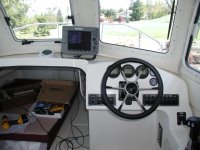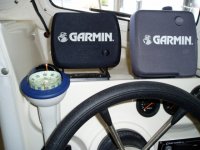I am a bit confused by It-sea-Bit-C's.. post. One generally steers by a compass by lining up the lubber line with the compass card bearing. I will take the course off the chart after making the appropiate corrections for variation and deviation. I would not suggest lining up some item with the boat, and taking a bearing that way. It is just not accurate enough. I have always wanted the compass to be as close to being in front of the helms person as possiable to avoid paralax error with the lubber line.
The compass needs to be absolutely lined up fore and aft--as part of the compensation. I prefer to use a Sun compass to do the compensation. Once you lean this technique, it is easy to reswing the compass before each passage--and you can be sure that the compass is properly compensated--or the proper deviation is applied as per the Napier diagram or deviation table you have constructed.
I also have the Ritchie Voyager--but it only has an "apparent 3 inch" compass card--in reality the card is 2 to 2.5". You cannot steer a one degree accurate course with these compasses. The compass divisions are 5 degrees and the lubber lines are a couple of degrees. I am used to at least a 4" card (that is what I grew up steering to) or the 5" Danforth Constillation or 5" Ritchie GlobeMaster. At one point I owned a 12" ships compass in a brass binnacle--a real work of art!.
Before GPS, one had to be able to steer a course which was very accurate, because Dead Reconing was one of the most common modes of navigation.
Recently I purchased a ComNav (Silva/Nixus) 35 degree heeling compensation flux gate compass with a 4" LCD display--which reads digital bearings, analogue bearings, and degrees off course on the display. It was only $40 at West Marine (I suspect it had been reduced from the $500 origional tag, since doesn not seem to be NMEA 0183 output.) Now I have to find room for this on the consule. Since this is self compensating, it should be easy to read and steer too.


